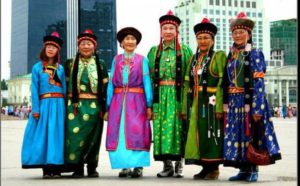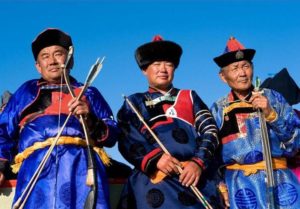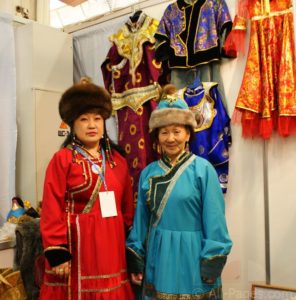The Buryats are a people who have lived since ancient times in the harsh conditions of Siberia near Lake Baikal. These are nomadic pastoralists and hunters. Long frosty winters and short cool summers led to the emergence of styles of warm clothing that should be comfortable when driving livestock and grazing them. These outfits are comfortable in hot and cold weather.
The history of the costume
 It is known that this people inhabited the Baikal region back in Paleolithic times. But the first description of the national Buryat costume dates back to the 17th century. One of the merchants, heading to China with the Russian embassy, described the life of the Buryat people and their costumes. Scientists began studying their origin, cut and characteristics only at the beginning of the 19th century.
It is known that this people inhabited the Baikal region back in Paleolithic times. But the first description of the national Buryat costume dates back to the 17th century. One of the merchants, heading to China with the Russian embassy, described the life of the Buryat people and their costumes. Scientists began studying their origin, cut and characteristics only at the beginning of the 19th century.
Buryat clothing was influenced by other cultures. Over time, cotton and silk fabrics from China and Central Asia began to appear among the people.
Types of suits
 The suit was supposed to warm the shepherd rider and not interfere with his handling of the herd. Harsh winters require warm clothing.Therefore, in traditional outfits there were two options: winter and summer. Men wore robes, which were always belted with silk sashes or leather belts decorated with silver and stones..
The suit was supposed to warm the shepherd rider and not interfere with his handling of the herd. Harsh winters require warm clothing.Therefore, in traditional outfits there were two options: winter and summer. Men wore robes, which were always belted with silk sashes or leather belts decorated with silver and stones..
The dressing gowns for winter and summer differed only in the material they were made of, everything else was the same. The cut was simple, but had interesting elements inherent in the clothing of this people:
- stand-up collar, loose robe allowing for a variety of movements;
- sleeves could be one-piece for protection from bad weather;
- the cone-shaped cuff turned away in cold weather, protecting the hand. It was usually embroidered with wool or silk threads. By the pattern it was possible to determine the wealth of the cattle breeder and the approximate number of heads in the herd;
- the hem of the robe was supposed to protect the rider’s legs from the cold, and, if necessary, serve as a bed for him on a nomadic camp.
Features of styles
 Men's robes had a straight cut with raglan sleeves. They were always worn under the belt. Children's robes were sewn in the same way. The styles were identical for both boys and girls. When the girl turned into a girl, the cut of the degel became more complicated and resembled a jacket and a skirt joined by a seam.
Men's robes had a straight cut with raglan sleeves. They were always worn under the belt. Children's robes were sewn in the same way. The styles were identical for both boys and girls. When the girl turned into a girl, the cut of the degel became more complicated and resembled a jacket and a skirt joined by a seam.
Sewing materials
Nomadic pastoralists had no other materials for sewing clothes, except for the skins of killed animals. Sheepskin, leather and wool, fur of fur-bearing animals - fox, arctic fox, sable, mink - were used. Later, silk, velvet, and cotton fabrics began to be purchased from other nations, and precious stones, gold, and silver were added to traditional jewelry.
The main element of national clothing is the robe. The winter one (degel) was made from sheepskin and had velvet trim. The robe for summer everyday life (terling) was light, cotton, and the festive robe was silk.
What colors are your priority?
 The favorite color of any Buryat was blue. These are the colors of the robe and hat. It symbolizes the infinity of the sky. But there were other colors of degel - brown, burgundy, green. The colored stripes of the enger (the quadrangular side of the degel) also carried a semantic meaning. For example, black symbolized the fertility of the earth, red – the energy of life and fire. The first stripe at the top could only be white or gold.
The favorite color of any Buryat was blue. These are the colors of the robe and hat. It symbolizes the infinity of the sky. But there were other colors of degel - brown, burgundy, green. The colored stripes of the enger (the quadrangular side of the degel) also carried a semantic meaning. For example, black symbolized the fertility of the earth, red – the energy of life and fire. The first stripe at the top could only be white or gold.
Jewelry for a suit
Women decorated themselves quite intricately. There were many rings on the hands, they were worn on each of the fingers, except for the middle one, and sometimes several pieces on one. Bracelets on each hand, earrings, chest decorations made of many rows of beads, silver medallions, amulets.
 Also, pendants made of beads of different sizes and colors were attached to the side of the temples. They could be very long and go down to the chest. Often the headband on the hat or pendant had silver elements. Braids were placed in special cases to preserve the magical power of women's hair.
Also, pendants made of beads of different sizes and colors were attached to the side of the temples. They could be very long and go down to the chest. Often the headband on the hat or pendant had silver elements. Braids were placed in special cases to preserve the magical power of women's hair.
Men complemented their costume with a knife (hutaga) and a flint (hete). Over time, they became only decorative elements, losing their utilitarianism. The handle of the knife and the sheath itself were decorated with embossing elements involving silver and gems. The flint was placed in a small leather bag with a steel at the bottom. Silver plates with intricate designs decorated it.
Shoes
 Buryat shoes - high boots made of foal skin or boots with toes pointed upward, similar to Turkish styles. These shoes were made for both men and women. It is comfortable, hygienic and practical. On top it was decorated with embroidery or stitches of contrasting threads with contours of patterns. Boots for winter were insulated with sheepskin or wild animal fur.Summer shoes were knitted from horsehair and attached to leather soles.
Buryat shoes - high boots made of foal skin or boots with toes pointed upward, similar to Turkish styles. These shoes were made for both men and women. It is comfortable, hygienic and practical. On top it was decorated with embroidery or stitches of contrasting threads with contours of patterns. Boots for winter were insulated with sheepskin or wild animal fur.Summer shoes were knitted from horsehair and attached to leather soles.
Hats
Traditionally, Buryat men and women wore hats. They differed in belonging to different genera, but were very interesting and varied. Among the forms the following stand out:
- Cap with fur trim at the bottom edge;
- Hats with earflaps made of long-pile fur - fox or arctic fox;
- Cone with a high crown. Each cap ended with a pointed top, decorated with a silver pommel and red tassels. The edges were bent. The crown of women's hats was embroidered with patterns of beads, ribbons, and silver.
All hats were made in blue. Each of the elements carried a semantic load.
Male, female, children - features
 The basis of the costume was a robe, and under it men wore leather or cloth pants and a cotton shirt. They were protected from bad weather by a saba (overcoat-type outerwear) worn over a degel. If it became very cold, the dakha (loose outer clothing with a fur outer layer) came to the rescue.
The basis of the costume was a robe, and under it men wore leather or cloth pants and a cotton shirt. They were protected from bad weather by a saba (overcoat-type outerwear) worn over a degel. If it became very cold, the dakha (loose outer clothing with a fur outer layer) came to the rescue.
When a girl got married, her outfit was a shirt, pants and a robe. A sleeveless vest was a mandatory element of the costume; without it and without a headdress, not a single Buryat woman had the right to appear among men. The sleeveless jacket was long or short, it depended on the gender and status of the woman. The edges of the vest were always decorated with ornamental embroidery and ribbons were sewn on.
Modern national costume of the Buryats
 The Buryat folk costume inspired domestic couturiers to create fashion collections with a folk flavor. In modern clothing, the most interesting details of the cut of the sleeves and the trapezoidal silhouette have been preserved. Much attention is also paid to creating headdresses with different lengths and shapes of the pommel..
The Buryat folk costume inspired domestic couturiers to create fashion collections with a folk flavor. In modern clothing, the most interesting details of the cut of the sleeves and the trapezoidal silhouette have been preserved. Much attention is also paid to creating headdresses with different lengths and shapes of the pommel..
Patterns of complex ornaments, designs of decorative elements, and silver jewelry are not ignored. In modern costumes, stylization of degel of various styles is popular. Evening dresses and outerwear are sewn taking into account the original cut of the sleeve, collar, enger - the quadrangular side of the degel.
Stylized national shoes - Uggs, high boots, fur boots - have migrated into the wardrobes of fashionistas around the world. Popular hats are made from the fur of arctic fox, fox, and silver fox.


 0
0




